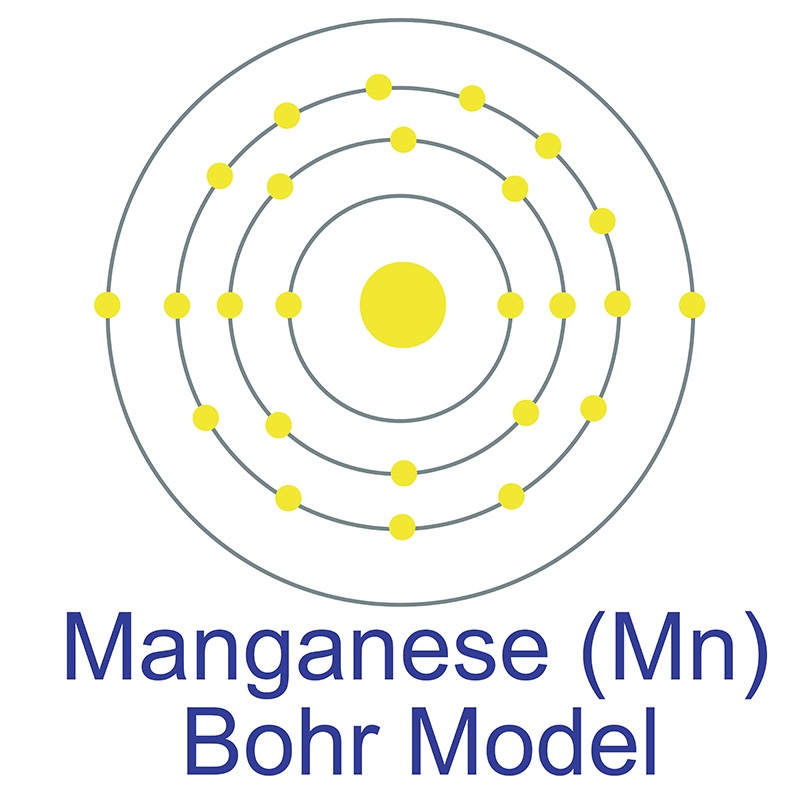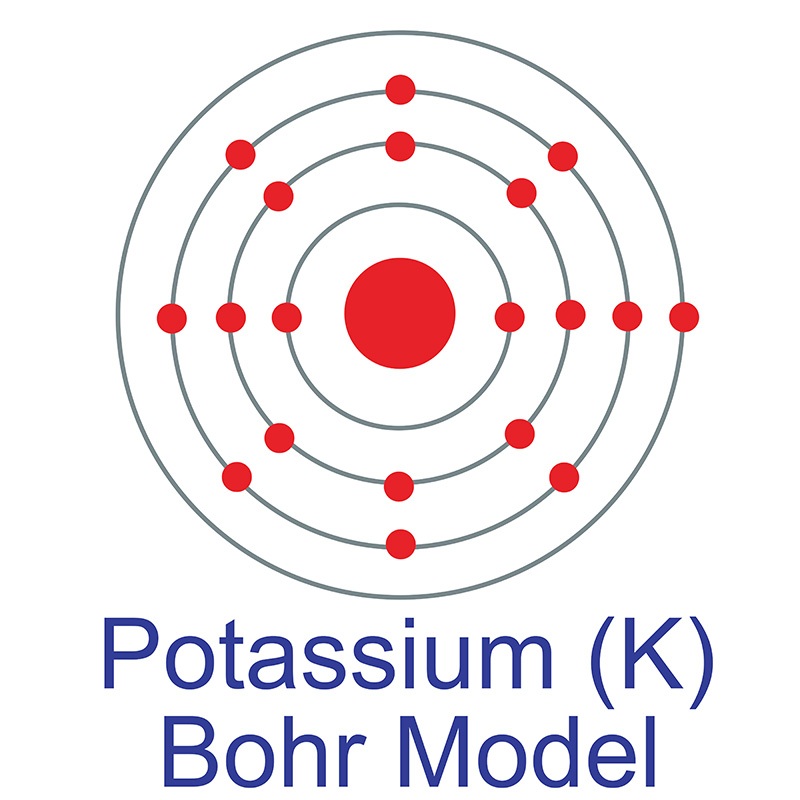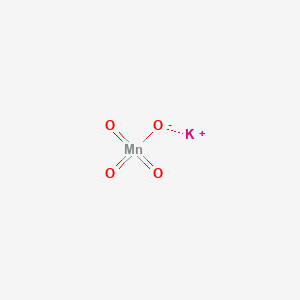SECTION 1. IDENTIFICATION
Product Name: Potassium Permanganate
Product Number: All applicable American Elements product codes, e.g. K-PMNO-02
, K-PMNO-025
, K-PMNO-03
, K-PMNO-035
, K-PMNO-04
, K-PMNO-05
CAS #: 7722-64-7
Relevant identified uses of the substance: Scientific research and development
Supplier details:
American Elements
10884 Weyburn Ave.
Los Angeles, CA 90024
Tel: +1 310-208-0551
Fax: +1 310-208-0351
Emergency telephone number:
Domestic, North America: +1 800-424-9300
International: +1 703-527-3887
SECTION 2. HAZARDS IDENTIFICATION
2.1 Classification of the substance or mixture
GHS Classification in accordance with 29 CFR 1910 (OSHA HCS)
Oxidizing solids (Category 2), H272
Acute toxicity, Oral (Category 4), H302
Acute aquatic toxicity (Category 1), H400
Chronic aquatic toxicity (Category 1), H410
2.2 GHS Label elements, including precautionary statements
Pictogram
Signal word Danger
Hazard statement(s)
H272 May intensify fire; oxidiser.
H302 Harmful if swallowed.
H410 Very toxic to aquatic life with long lasting effects.
Precautionary statement(s)
P210 Keep away from heat.
P220 Keep/Store away from clothing/ combustible materials.
P221 Take any precaution to avoid mixing with combustibles.
P264 Wash skin thoroughly after handling.
P270 Do not eat, drink or smoke when using this product.
P273 Avoid release to the environment.P280 Wear protective gloves/ protective clothing/ eye protection/ face
protection.
P301 + P312 IF SWALLOWED: Call a POISON CENTER or doctor/ physician if you
feel unwell.
P330 Rinse mouth.
P370 + P378 In case of fire: Use dry sand, dry chemical or alcohol-resistant foam for
extinction.
P391 Collect spillage.
P501 Dispose of contents/ container to an approved waste disposal plant.
2.3 Hazards not otherwise classified (HNOC) or not covered by GHS - none
SECTION 3. COMPOSITION/INFORMATION ON INGREDIENTS
3.1 Substances
Formula : KMnO4
Molecular weight : 158.03 g/mol
CAS-No. : 7722-64-7
EC-No. : 231-760-3
Index-No. : 025-002-00-9
Hazardous components
Component Classification Concentration
Potassium permanganate
Ox. Sol. 2; Acute Tox. 4; Skin
Corr. 1B; Eye Dam. 1; Aquatic
Acute 1; Aquatic Chronic 1;
H272, H302, H314, H410
<= 100 %
SECTION 4. FIRST AID MEASURES
4.1 Description of first aid measures
General advice
Consult a physician. Show this safety data sheet to the doctor in attendance.Move out of dangerous area.
If inhaled
If breathed in, move person into fresh air. If not breathing, give artificial respiration. Consult a physician.
In case of skin contact
Wash off with soap and plenty of water. Consult a physician.
In case of eye contact
Flush eyes with water as a precaution.
If swallowed
Never give anything by mouth to an unconscious person. Rinse mouth with water. Consult a physician.
4.2 Most important symptoms and effects, both acute and delayed
The most important known symptoms and effects are described in the labelling (see section 2.2) and/or in section 11
4.3 Indication of any immediate medical attention and special treatment needed
No data available
SECTION 5. FIREFIGHTING MEASURES
5.1 Extinguishing media
Suitable extinguishing media
Use water spray, alcohol-resistant foam, dry chemical or carbon dioxide.
5.2 Special hazards arising from the substance or mixture
Potassium oxides, Manganese/manganese oxides
5.3 Advice for firefighters
Wear self-contained breathing apparatus for firefighting if necessary.
5.4 Further information
Use water spray to cool unopened containers.
SECTION 6. ACCIDENTAL RELEASE MEASURES
6.1 Personal precautions, protective equipment and emergency procedures
Use personal protective equipment. Avoid dust formation. Avoid breathing Vapors, mist or gas. Ensure adequate
ventilation. Evacuate personnel to safe areas. Avoid breathing dust.
For personal protection see section 8.
6.2 Environmental precautions
Prevent further leakage or spillage if safe to do so. Do not let product enter drains. Discharge into the environment
must be avoided.
6.3 Methods and materials for containment and cleaning up
Sweep up and shovel. Contain spillage, and then collect with an electrically protected vacuum cleaner or by wetbrushing
and place in container for disposal according to local regulations (see section 13). Keep in suitable, closed
containers for disposal.
6.4 Reference to other sections
For disposal see section 13.
SECTION 7. HANDLING AND STORAGE
7.1 Precautions for safe handling
Avoid contact with skin and eyes. Avoid formation of dust and aerosols.
Provide appropriate exhaust ventilation at places where dust is formed.Keep away from sources of ignition - No
smoking.Keep away from heat and sources of ignition.
For precautions see section 2.2.
7.2 Conditions for safe storage, including any incompatibilities
Keep container tightly closed in a dry and well-ventilated place.
7.3 Specific end use(s)
Apart from the uses mentioned in section 1.2 no other specific uses are stipulated
SECTION 8. EXPOSURE CONTROLS/PERSONAL PROTECTION
8.1 Control parameters
Components with workplace control parameters
Component / CAS-No.
Value / Control parameters / Basis
Potassium permanganate 7722-64-7 C
5.000000 mg/m3 USA. Occupational Exposure Limits (OSHA) - Table Z-1 Limits for Air Contaminants
Remarks Ceiling limit is to be determined from breathing-zone air samples.
TWA "0.200000 mg/m3" "USA. ACGIH Threshold Limit Values (TLV)"
"Central Nervous System impairment
Adopted values or notations enclosed are those for which changes are proposed in the NIC
See Notice of Intended Changes (NIC)
varies"
TWA 1.000000 mg/m3 "USA. NIOSH Recommended Exposure Limits"
ST "3.000000 mg/m3" "USA. NIOSH Recommended Exposure Limits"
TWA "0.100000 mg/m3" "USA. ACGIH Threshold Limit Values (TLV)"
"Central Nervous System impairment 2014 Adoption varies"
TWA "0.020000 mg/m3" "USA. ACGIH Threshold Limit Values (TLV)"
"Central Nervous System impairment 2014 Adoption varies"
C 5 mg/m3 "USA. Occupational Exposure Limits (OSHA) - Table Z-1 Limits for Air Contaminants"
Ceiling limit is to be determined from breathing-zone air samples.
TWA 0.1 mg/m3 "USA. ACGIH Threshold Limit Values (TLV)"
Central Nervous System impairment varies
TWA 0.02 mg/m3 "USA. ACGIH Threshold Limit Values (TLV)"
Central Nervous System impairment varies
TWA 1 mg/m3 "USA. NIOSH Recommended Exposure Limits"
ST 3 mg/m3 "USA. NIOSH Recommended Exposure Limits"
8.2 Exposure controls
Appropriate engineering controls
Handle in accordance with good industrial hygiene and safety practice. Wash hands before breaks and at the end of
workday.
Personal protective equipment
Eye/face protection
Safety glasses with side-shields conforming to EN166 Use equipment for eye protection tested and approved
under appropriate government standards such as NIOSH (US) or EN 166(EU).
Skin protection
Handle with gloves. Gloves must be inspected prior to use. Use proper glove removal technique (without
touching glove's outer surface) to avoid skin contact with this product. Dispose of contaminated gloves after
use in accordance with applicable laws and good laboratory practices. Wash and dry hands.Body Protection
Complete suit protecting against chemicals, The type of protective equipment must be selected according to
the concentration and amount of the dangerous substance at the specific workplace.
Respiratory protection
Where risk assessment shows air-purifying respirators are appropriate use a full-face particle respirator type
N100 (US) or type P3 (EN 143) respirator cartridges as a backup to engineering controls. If the respirator is the
sole means of protection, use a full-face supplied air respirator. Use respirators and components tested and
approved under appropriate government standards such as NIOSH (US) or CEN (EU).
Control of environmental exposure
Prevent further leakage or spillage if safe to do so. Do not let product enter drains. Discharge into the
environment must be avoided.
SECTION 9. PHYSICAL AND CHEMICAL PROPERTIES
9.1 Information on basic physical and chemical properties
a) Appearance Form: crystalline
Colour: dark violet
b) Odor No data available
c) Odor Threshold No data available
d) pH No data available
e) Melting point/freezing point
Melting point/range: 240 °C (464 °F)
f) Initial boiling point and boiling range
No data available
g) Flash point N/A
h) Evaporation rate No data available
i) Flammability (solid, gas) No data available
j) Upper/lower flammability or explosive limits
No data available
k) Vapor pressure No data available
l) Vapor density No data available
m) Relative density 2.710 g/cm3
n) Water solubility No data available
o) Partition coefficient: noctanol/ water
No data available
p) Auto-ignition temperature
No data available
q) Decomposition temperature
No data available
r) Viscosity No data available
s) Explosive properties No data available
t) Oxidizing properties The substance or mixture is classified as oxidizing with the category 2.
9.2 Other safety information
No data available
SECTION 10. STABILITY AND REACTIVITY
10.1 Reactivity
No data available
10.2 Chemical stability
Stable under recommended storage conditions.
10.3 Possibility of hazardous reactions
No data available
10.4 Conditions to avoid
No data available
10.5 Incompatible materials
Strong reducing agents, Powdered metals, Peroxides, Zinc, Copper
10.6 Hazardous decomposition products
Other decomposition products - No data available
In the event of fire: see section 5
SECTION 11. TOXICOLOGICAL INFORMATION
11.1 Information on toxicological effects
Acute toxicity
LD50 Oral - Rat - 1,090 mg/kg
Inhalation: No data available
Dermal: No data available
No data available
Skin corrosion/irritation
Skin - Rabbit
Result: Corrosive - 4 h
Serious eye damage/eye irritation
No data available
Respiratory or skin sensitisation
Maximisation Test (GPMT) - Guinea pig
Result: Does not cause skin sensitisation.
(OECD Test Guideline 406)
Germ cell mutagenicity
No data available
Carcinogenicity
IARC: No component of this product present at levels greater than or equal to 0.1% is identified as
probable, possible or confirmed human carcinogen by IARC.
ACGIH: No component of this product present at levels greater than or equal to 0.1% is identified as a
carcinogen or potential carcinogen by ACGIH.
NTP: No component of this product present at levels greater than or equal to 0.1% is identified as a
known or anticipated carcinogen by NTP.
OSHA: No component of this product present at levels greater than or equal to 0.1% is identified as a
carcinogen or potential carcinogen by OSHA.Reproductive toxicity
No data available
No data available
Specific target organ toxicity - single exposure
No data available
Specific target organ toxicity - repeated exposure
No data available
Aspiration hazard
No data available
Additional Information
RTECS: SD6475000
Contact with skin can cause:, Oedema, Necrosis, Effects due to ingestion may include:, methemoglobinema,
psychological disturbances, Vomiting, Nausea, Diarrhoea
SECTION 12. ECOLOGICAL INFORMATION
12.1 Toxicity
Toxicity to fish LC50 - Oncorhynchus mykiss (rainbow trout) - 0.3 - 0.6 mg/l - 96.0 h
Toxicity to daphnia and
other aquatic
invertebrates
EC50 - Daphnia magna (Water flea) - 0.084 mg/l - 48 h
12.2 Persistence and degradability
The methods for determining biodegradability are not applicable to inorganic substances.
12.3 Bioaccumulative potential
Bioaccumulation Lamellibranchia (mussel)
Bioconcentration factor (BCF): < 10,000
Remarks: Can accumulate in aquatic organisms.
12.4 Mobility in soil
No data available
12.5 Results of PBT and vPvB assessment
PBT/vPvB assessment not available as chemical safety assessment not required/not conducted
12.6 Other adverse effects
An environmental hazard cannot be excluded in the event of unprofessional handling or disposal.
Very toxic to aquatic life.
SECTION 13. DISPOSAL CONSIDERATIONS
13.1 Waste treatment methods
Product
Burn in a chemical incinerator equipped with an afterburner and scrubber but exert extra care in igniting as this
material is highly flammable. Offer surplus and non-recyclable solutions to a licensed disposal company. Contact a
licensed professional waste disposal service to dispose of this material.
Contaminated packaging
Dispose of as unused product.
SECTION 14. TRANSPORT INFORMATION
DOT (US)
UN number: 1490 Class: 5.1 Packing group: II
Proper shipping name: Potassium permanganate
Reportable Quantity (RQ): 100 lbs
Poison Inhalation Hazard: No
IMDG
UN number: 1490 Class: 5.1 Packing group: II EMS-No: F-H, S-Q
Proper shipping name: POTASSIUM PERMANGANATE
Marine pollutant:yes
IATAUN number: 1490 Class: 5.1 Packing group: II
Proper shipping name: Potassium permanganate
SECTION 15. REGULATORY INFORMATION
SARA 302 Components
No chemicals in this material are subject to the reporting requirements of SARA Title III, Section 302.
SARA 313 Components
The following components are subject to reporting levels established by SARA Title III, Section 313:
Potassium permanganate
CAS-No.
7722-64-7
Revision Date
1993-04-24
SARA 311/312 Hazards
Reactivity Hazard, Acute Health Hazard
Massachusetts Right To Know Components
Potassium permanganate
CAS-No.
7722-64-7
Revision Date
1993-04-24
Pennsylvania Right To Know Components
Potassium permanganate
CAS-No.
7722-64-7
Revision Date
1993-04-24
New Jersey Right To Know Components
Potassium permanganate
CAS-No.
7722-64-7
Revision Date
1993-04-24
California Prop. 65 Components
This product does not contain any chemicals known to State of California to cause cancer, birth defects, or any other
reproductive harm.
SECTION 16. OTHER INFORMATION
Safety Data Sheet according to Regulation (EC) No. 1907/2006 (REACH). The above information is believed to be correct but does not purport to be all inclusive and shall be used only as a guide. The information in this document is based on the present state of our knowledge and is applicable to the product with regard to appropriate safety precautions. It does not represent any guarantee of the properties of the product. American Elements shall not be held liable for any damage resulting from handling or from contact with the above product. See reverse side of invoice or packing slip for additional terms and conditions of sale. COPYRIGHT 1997-2022 AMERICAN ELEMENTS. LICENSED GRANTED TO MAKE UNLIMITED PAPER COPIES FOR INTERNAL USE ONLY.
 The number of electrons in each of Manganese's shells is [2, 8, 13, 2] and its electron configuration is [Ar] 3d5 4s2. The manganese atom has a radius of 127 pm and a Van der Waals radius of 197 pm. Manganese was first discovered by Torbern Olof Bergman in 1770 and first isolated by Johann Gottlieb Gahn in 1774. In its elemental form, manganese has a silvery metallic appearance.
The number of electrons in each of Manganese's shells is [2, 8, 13, 2] and its electron configuration is [Ar] 3d5 4s2. The manganese atom has a radius of 127 pm and a Van der Waals radius of 197 pm. Manganese was first discovered by Torbern Olof Bergman in 1770 and first isolated by Johann Gottlieb Gahn in 1774. In its elemental form, manganese has a silvery metallic appearance.  It is a paramagnetic metal that oxidizes easily in addition to being very hard and brittle. Manganese is found as a free element in nature and also in the minerals pyrolusite, braunite, psilomelane, and rhodochrosite. The name Manganese originates from the Latin word mangnes, meaning "magnet."
It is a paramagnetic metal that oxidizes easily in addition to being very hard and brittle. Manganese is found as a free element in nature and also in the minerals pyrolusite, braunite, psilomelane, and rhodochrosite. The name Manganese originates from the Latin word mangnes, meaning "magnet." See more Potassium products.
See more Potassium products. In its elemental form, potassium has a silvery gray metallic appearance, but its
In its elemental form, potassium has a silvery gray metallic appearance, but its 
